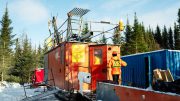CHIBOUGAMAU, QUE. — When Franois Fleury, the general manager of the Troilus gold mine, praised the “ingenuity and tenacity” of the Troilus workforce, he had good reason to mean it. The mine, two hours’ drive north of Chibougamau, is a powerful example of how deposits are discovered, but mines are made.
Troilus, which poured its millionth ounce of gold in early July, was unlucky enough to meet the decline in the gold price head-on when it opened in 1997. Mining a slim 1-gram-per-tonne grade, it found itself with no room for mistakes.
Yet six years later, instead of making plans for closure, owner Inmet Mining (imn-t) is watching Troilus come into its own as a low-grade, high-tonnage gold producer. Costs have fallen significantly, largely thanks to a realization that the Troilus deposit lends itself to the efficiencies that come with bulk mining. Moreover, a new resource estimate, based on the economics of the bulk-mining operation, has added four more years to Troilus’s mine life.
The Northern Miner recently visited the Troilus operation, and what appears is a mine whose time may at last have come — thanks partly to an improved gold price, but mostly to a creative approach to mining — and a major mill expansion.
It wasn’t always this way. Shortly before opening Troilus, Inmet — sensing trouble in the gold business, and a possible low-grade, high-cost trap at the project itself, and thinking gold-mining specialists might be better able to make a go of the operation — began to look for buyers. Ultimately Homestake Mining concluded a deal with Inmet, only to drop out before the deal closed. The failed sale became a legal dispute between Inmet and Barrick Gold (abx-t), which had taken over Homestake; Inmet sued for specific performance of the sale contract and the British Columbia Supreme Court awarded the company $88 million, a decision Homestake is appealing.
But if you can’t sell a mine, the best course is to make it pay. And over the past several years, Troilus has been turned into a mine that makes a healthy operating profit — $6 million in the first half of 2003.
Troilus’s main pit, the Z-87, is now about 1 km long and 200 metres deep, and altogether about 100 million tonnes of rock have been moved — a measure of the relatively high stripping ratio the deposit faced in its early years. The operation’s 150-tonne trucks haul some 45,000 tonnes of material out of the pit each day, about a third of which goes to the mill.
The new resource estimate, partly made in-house but signed off by consultants Roscoe Postle Associates, came out in April and reflected the state of the pits at the end of 2002. Measured and indicated resources in the Z-87 pit stood at 39.6 million tonnes grading 0.98 gram gold and 0.11% copper, with a further 10.7 million tonnes of inferred resources grading 0.94 gram gold and 0.1% copper.
The Z-87 deposit is hosted in a diorite intrusion. The mineralization is in a northwest-dipping zone of intrusive breccia and quartz-feldspar dykes, both of which can host the gold. Higher-grade oreshoots plunge northward.
One pleasant surprise for Troilus has been the satellite J4 pit. It was test-mined in November 2002 to establish its suitability for milling, then a single slash was mined from the pit in the first three months of 2002 while the main pit was undergoing stripping. The millhead grade turned out to be 1.4 grams gold per tonne, which came as a bonus during a lean period from the Z-87 pit.
The new resource estimate — made before the initial mining at J4 — put the size of the J4 deposit at 18.1 million tonnes grading 0.92 gram gold per tonne and 0.06% copper. J4, hosted in the same rocks as its big brother, is in a slightly more steeply-dipping structure, and has a distinctly lower copper grade.
It’s in the mill that the visitor sees the big difference in Troilus. This is no narrow-vein gold mine: the mill doesn’t even have a leach circuit. Instead, it relies on gravity concentration to pull out the coarse gold, then produces a flotation concentrate that goes to the Horne smelter in Rouyn-Noranda, Que.
A milling rate of 15,000 tonnes per day means a big crushing operation. Ore starts at a main crusher that produces a feed of minus-50-mm and plus-125-mm material for a semi-autogenous grinding (SAG) mill. Material in the 50- to 125-mm window is returned to a secondary crusher. It’s the use of a bimodal size distribution in the mill that has allowed Inmet to reduce milling costs at Troilus, down to about US$50 per oz. “Had we not done that, I don’t think we could have survived,” says Yvon Sylvestre, mill superintendent. “It brought us back to where we could compete more evenly.”
About 28% of the gold is recovered by gravity, although recoveries from J4 ore, which has coarser gold, have been as high as 40%. The rest goes to flotation cells that produce a 22%-copper concentrate; it’s a clean concentrate without significant amounts of penalty metals like arsenic. Altogether the mill gets about 90% of the gold from Troilus ore.
Troilus’s low grades still leave little margin for error in grade control. Chief Engineer Eric Lamontagne told the Miner that in the mine’s early stages of operation, grade reconciliations were poor, with millhead grades sometimes falling as far as 15% below reserve grades. Taking larger samples proved to be one answer, but there were others: geostatistical reserve estimates were revised, using as many as 14 separate envelopes to calculate the tonnage of mining blocks. Now grade reconciliations come as close as 1%. “Sampling protocol has permitted significant reductions in the dilution,” says mill superintendent Sylvestre.
Any operation that mines 45,000 tonnes and mills 15,000 tonnes in a day soon finds a need for adequate tailings disposal. Troilus’s 3-km tailings dyke, currently being raised, holds back a 300-hectare area of fine mill tailings. Pierre Roy, who has charge of environmental management, told the Miner that the tailings themselves have the ideal geotechnical characteristics to be used as the core for the tailings dam: they are fine enough to limit water flow, but still relatively easy to compact.
Another role has fallen to Troilus in the years that saw other Chibougamau-area operations close down or cut back: it is now the major resource-industry employer in the region, putting about $28 million into services from suppliers in the region and paying a comparable amount in wages.
About 70% of the workforce was hired locally, including 20-25% from the Cree communities of Ouje-Bougoumou and Mistissini. (There is an explicit goal of 25% Cree employment written into the mine’s benefits agreement with the communities.)
The mine is non-union, but Pierre Drapeau, human-resources director, says the salary and benefits are competitive and the company tries to be responsive to the concerns of the workforce through frequent meetings and through an elected labour-relations committee. The operation has been highly successful in its health and safety record, taking both the national John T. Ryan and the provincial O’Connell trophies for mine safety in recent years. “It’s a continuous process,” says Drapeau. “You have to work with people to build a safety-and-health culture.” The culture extends to the mine’s contractors, who get a Troilus training session before beginning work; the goal, says Drapeau, is to have contractors with equal or better accident rates than the in-house employees.
A seven-day-in/seven-out work cycle means that about 100 mine and 50 maintenance employees are on site at any one time. Most live in Chibougamau or Chapais.
The local Cree communities gained both from an initial benefits agreement — which gave them about $500,000, most of which went into training programs — and by the development of marketable skills. Most Cree employees at Troilus have become equipment operators, but they can also be found as samplers and in the laboratory and the mill. The other side of that coin is a drain of trained Cree employees with portable skills to other employers in the region, particularly Hydro-Quebec’s Eastmain construction projects.
It’s in recognizing the limitations of a low-grade deposit that Troilus has found success where there could have been failure. “Doing things differently,” says Yvon Sylvestre, “has permitted us to be profitable today.”




Be the first to comment on "Site visit: How do they do it? Volume, volume, volume"